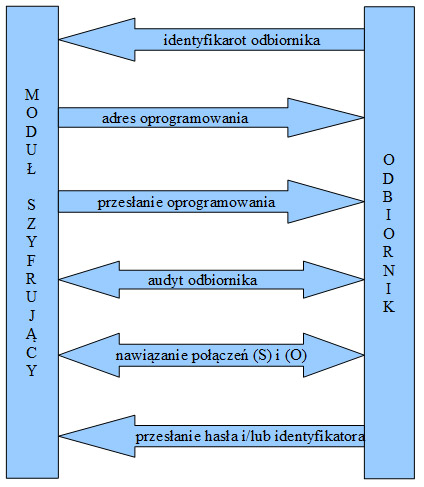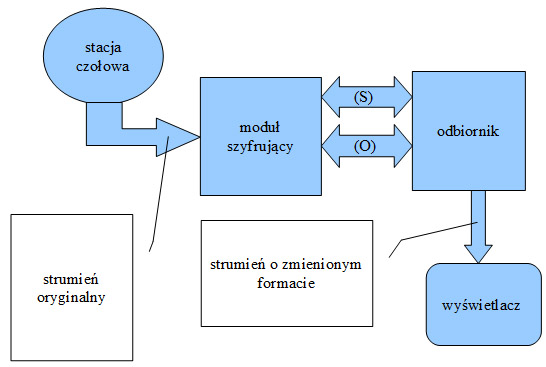DIGITAL TV SYSTEM DISTRIBUTION
WITH A VERY HIGH SECURITY LEVEL
KORSEC is a system of digital content distribution. A security
level of KORSEC is very high, much higher than other system like Conax
or Latens. KORSEC based on SSH code family, which are used as a security
code of bank transaction.
The system contain two type of equipments: the first one is a
server-coder SETTOBBOX, the second type is a SETTOPBOX. The STB is
implemented with a code-protocol compatible with coder-server. The
content data are sent to the STB as coded data and directly to the STB,
which pass the authorisation process. The stream method is UNICAST. The
way give us a full control of user, because the stream is coded
individually. We are able to prepare a table of every channel and user,
when the user turned on the STB equipment, when he set certain channel,
how long the data have been sent, when the channel stopped, what action
of user was after etc.
There is no way to register in KORSEC the ideal copy of the authorised
STB at the same time.
The KORSEC drops the second try of authorisation of “the same” STB.
What's more, this fact is automatically register and send to the
administrator.
Weeks of system:
1. the summarize bandwitch of content is growing proportional to numbers of active users
2. relatively high digital power is needed by AES coder, specially at server side
3. The output of the system is protected by DHCP protocol. There is no
other popular and strong protocols compatible with hardware to chose.
Nowadays is not a problem with many gigabits bandwitch and high computing power, although it is steel some expensive.
Strong sides of system:
1. high level of transmission security to a settopbox
2. tolerance of a data lost in transmission. It is no any MPEG artefacts at TV screen.
About SHH:
Secure Shell or SSH is a network protocol that allows data to be
exchanged over a secure channel between two computers. Encryption
provides confidentiality and integrity of data. SSH uses public-key
cryptography to authenticate the remote computer and allow the remote
computer to authenticate the user, if necessary.
SSH is typically used to log into a remote machine and execute commands,
but it also supports tunneling, forwarding arbitrary TCP ports and X11
connections; it can transfer files using the associated SFTP or SCP
protocols.
SSH architecture
Diagram of the SSH-2 binary packet.
The SSH-2 protocol has a clean internal architecture (defined in RFC 4251) with well-separated layers. These are:
The transport layer (RFC 4253). This layer handles initial key
exchange and server authentication and sets up encryption, compression
and integrity verification. It exposes to the upper layer an interface
for sending and receiving plaintext packets of up to 32,768 bytes each
(more can be allowed by the implementation). The transport layer also
arranges for key re-exchange, usually after 1 GB of data has been
transferred or after 1 hour has passed, whichever is sooner.
The user authentication layer (RFC 4252). This layer handles
client authentication and provides a number of authentication methods.
Authentication is client-driven, a fact commonly misunderstood by users;
when one is prompted for a password, it may be the SSH client
prompting, not the server. The server merely responds to client's
authentication requests. Widely used user authentication methods include
the following:
"password": a method for straightforward password authentication,
including a facility allowing a password to be changed. This method is
not implemented by all programs.
"publickey": a method for public key-based authentication, usually
supporting at least DSA or RSA keypairs, with other implementations also
supporting X.509 certificates.
"keyboard-interactive" (RFC 4256): a versatile method where the
server sends one or more prompts to enter information and the client
displays them and sends back responses keyed-in by the user. Used to
provide one-time password authentication such as S/Key or SecurID. Used
by some OpenSSH configurations when PAM is the underlying host
authentication provider to effectively provide password authentication,
sometimes leading to inability to log in with a client that supports
just the plain "password" authentication method.
GSSAPI authentication methods which provide an extensible scheme to
perform SSH authentication using external mechanisms such as Kerberos 5
or NTLM, providing single sign on capability to SSH sessions. These
methods are usually implemented by commercial SSH implementations for
use in organizations, though OpenSSH does have a working GSSAPI
implementation.
The connection layer (RFC 4254). This layer defines the concept of
channels, channel requests and global requests using which SSH services
are provided. A single SSH connection can host multiple channels
simultaneously, each transferring data in both directions. Channel
requests are used to relay out-of-band channel specific data, such as
the changed size of a terminal window or the exit code of a server-side
process. The SSH client requests a server-side port to be forwarded
using a global request. Standard channel types include:
"shell" for terminal shells, SFTP and exec requests (including SCP
transfers)
"direct-tcpip" for client-to-server forwarded connections
"forwarded-tcpip" for server-to-client forwarded connections
This open architecture provides considerable flexibility, allowing SSH
to be used for a variety of purposes beyond secure shell. The
functionality of the transport layer alone is comparable to TLS; the
user authentication layer is highly extensible with custom
authentication methods; and the connection layer provides the ability to
multiplex many secondary sessions into a single SSH connection, a
feature comparable to BEEP and not available in TLS.
Rys. 1 - Schemat autoryzacji odbiornika w systemie
Rys. 2 - Schemat połączeń logicznych



